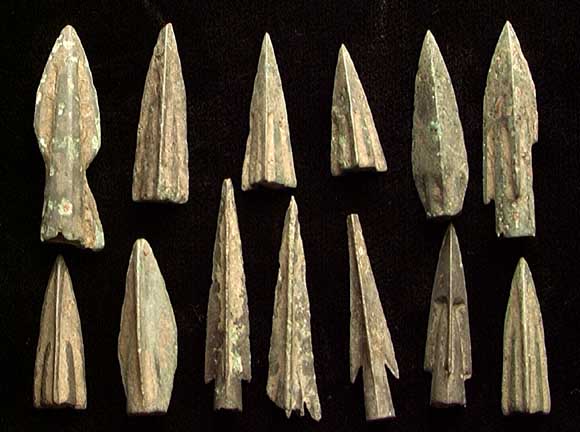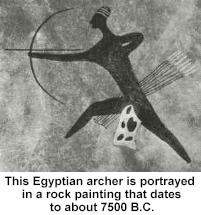The first arrow heads were found in Africa and date back to about
25,000 BC. Scientists believe that the bow was created sometime
after the creation of the spear thrower. After the initial
creation of the bow man began to improve upon his design. Fire
was used to harden arrow heads, and later feathers were added to the
arrows to improve accuracy.

Bronze arrow heads (image credit to: www.edgarlowen.com/specials.html)
Man started to make significant improvements in the bow and arrow over time. In approximately 2800 BC the first bow made of one or more materials was produced by the egyptians, this bow was made with wood, tipped with animal horn and held together with animal sinew and glue. The bow shot very light arrows up to 400 yards and could easily penetrate the armour of the day. The bowstring was made from sheep intestine.

(image credit to:
http://www.hickoksports.com/images/egyptian_archer.jpg)
Bronze arrow heads (image credit to: www.edgarlowen.com/
Man started to make significant improvements in the bow and arrow over time. In approximately 2800 BC the first bow made of one or more materials was produced by the egyptians, this bow was made with wood, tipped with animal horn and held together with animal sinew and glue. The bow shot very light arrows up to 400 yards and could easily penetrate the armour of the day. The bowstring was made from sheep intestine.

The indians and eskimos
of North America were proficient
with bow and arrow a lot longer than the European cultures. In
open areas strong bows that could fire a great range were used.
In heavy woodland where stealth and hunting expirence was needed
lighter bows were used. The last early bow used by natives on the
North American continent was the bow of the Eskimos. The Eskimo
bow was constructed from spruce and sinew, this bow was used for
hunting as well as warfare. The arrows used by the Eskimos were
constructed from either driftwood or splintered mammoth bones.
The arrows were tipped with needle like bones. Interest in the
bow and arrow slowed down in North America with the advent of firearms,
although archers like Howard Hill helped preserve interest in the
sport. After World War II American sportsmen began to rediscover
archery.
Not only did American sportsmen rediscover archer buy so to did scientists. Scientists started to take interest in the physics behind archery and established a criteria for the efficiency of bows and arrows. Later scientists, and bowmakers began to experiment with new materials, namely fiberglass, in the design and manufacturing of bows. This website will take a look at some of the interesting physical aspects of traditional bows, and more recently developed compound bows, and the flight of arrows.
Not only did American sportsmen rediscover archer buy so to did scientists. Scientists started to take interest in the physics behind archery and established a criteria for the efficiency of bows and arrows. Later scientists, and bowmakers began to experiment with new materials, namely fiberglass, in the design and manufacturing of bows. This website will take a look at some of the interesting physical aspects of traditional bows, and more recently developed compound bows, and the flight of arrows.
Home